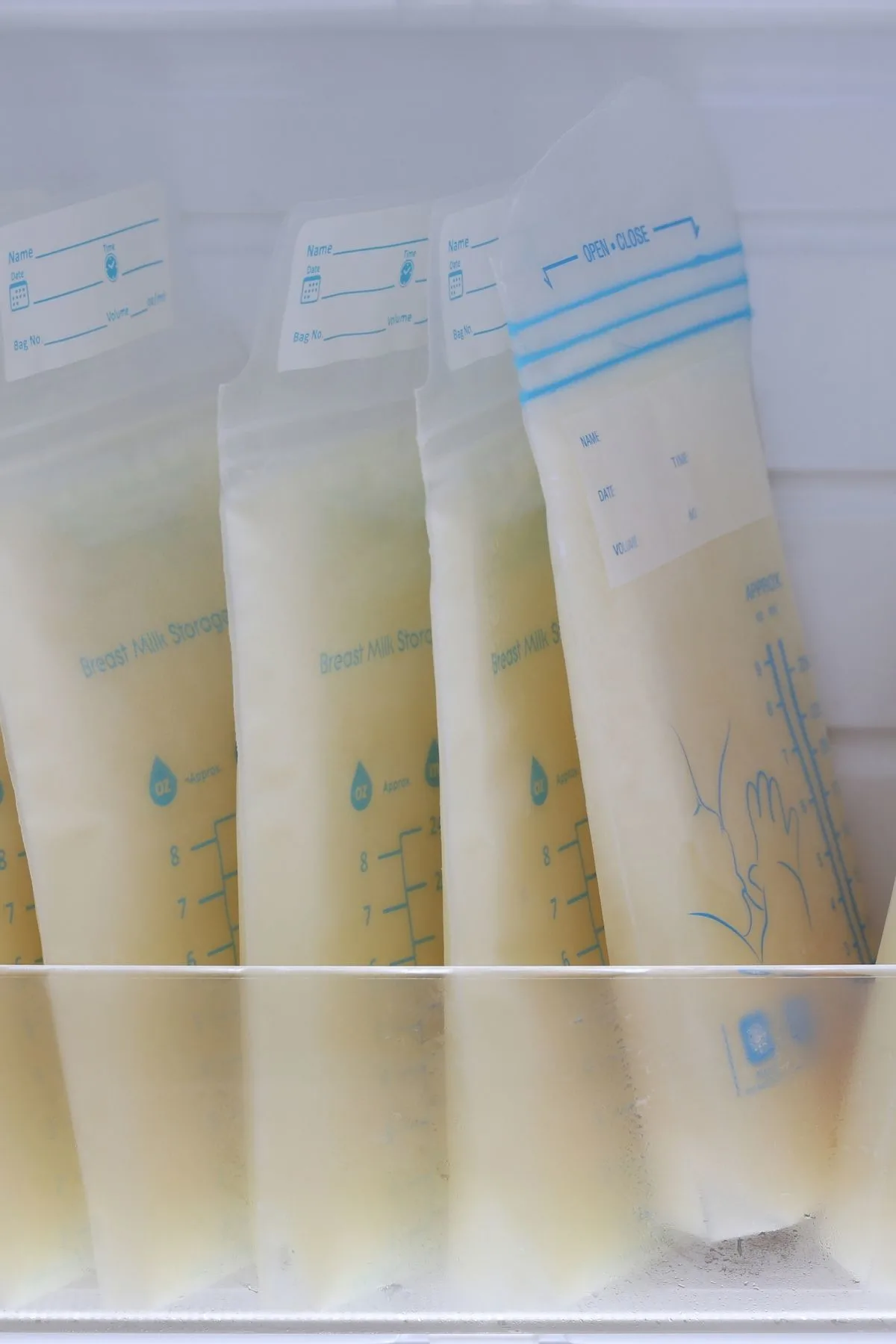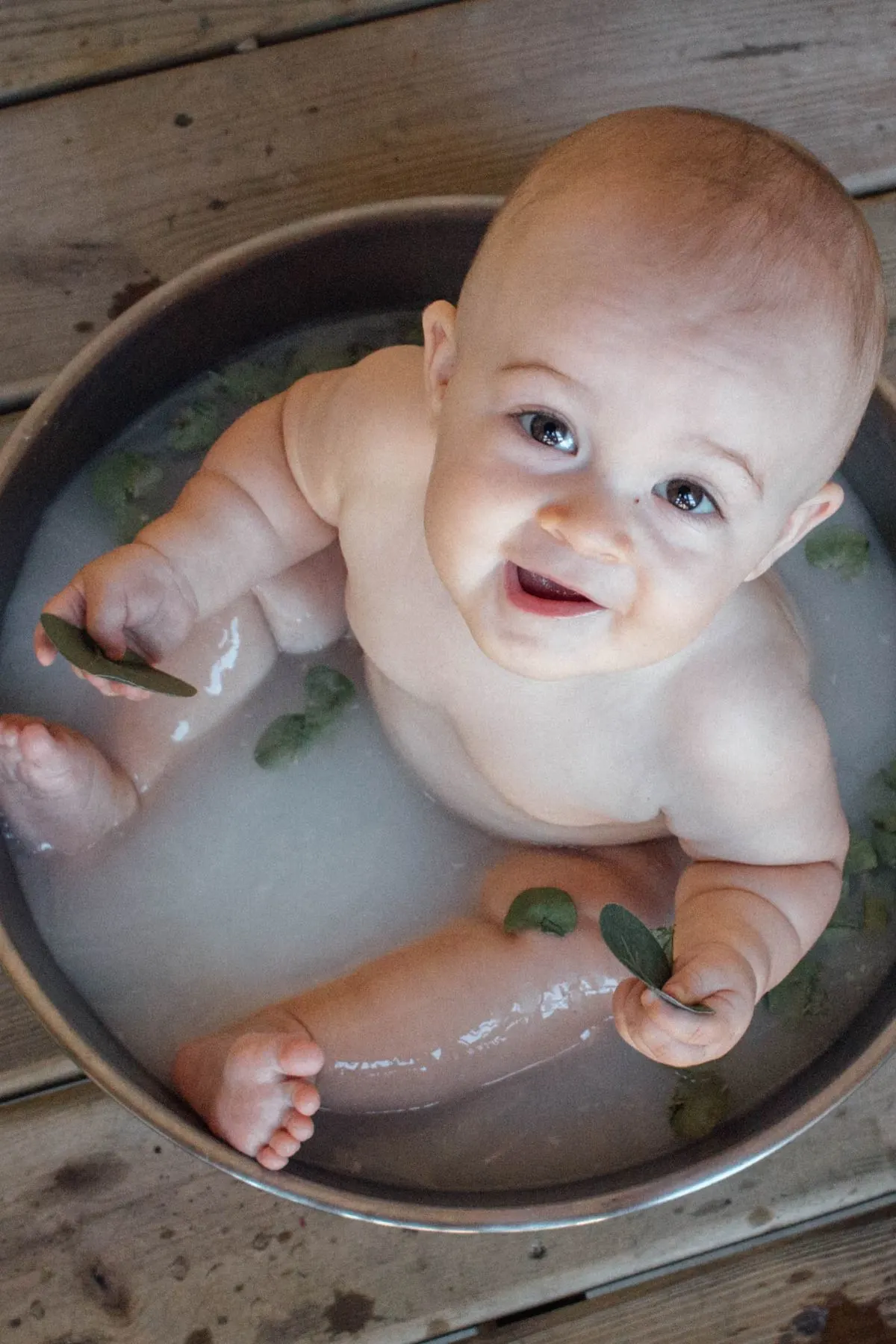Can you store breast milk in bags? Here’s everything you need to know, plus other breast milk and pumping tips for new moms!
If you’re a first time mom, you may feel a little intimidated by the prospect of breastfeeding feeding and pumping.
There’s a lot that goes into it, including finding the right equipment, maintaining your milk supply, and keeping up with your baby’s schedule.
But, one of the most common concerns for new moms is understanding the best way to store their expressed milk.
Thankfully, we’ve got all the information you need!
Below we’ve listed the best storage options, including safe breast milk storage bags, and important breast milk storage guidelines to follow.
Is it safe to store breast milk in bags?

Yes!
You can store breast milk in bags. But, you should only use bags specifically made to store human milk.
According to the CDC, you should never store breast milk in disposable bottle liners or plastic bags that are not intended for storing breast milk.
Safe Bags for Breast Milk
It’s safe to use any disposable breast milk storage bag that was created for the sole purpose of storing breast milk.
These pouches are made without any toxic materials. And they’re generally pre-sterilized, made for one-time use, and come with volume markers.
You can also use reusable breast milk storage bags made from food-grade silicone.
These bags are durable and washable. And they can be cleaned the same way you would your breast pump parts and baby bottles.
Unsafe Bags for Breast Milk

You should not store breast milk in any of the following:
- Ziploc bags (even with a double zipper seal)
- Freezer bags
- Sandwich bags
- Generic plastic bags
- Glad bags
Other Safe Storage Container Options

It’s also safe to use clean, food-grade containers to store expressed breast milk.
These include:
- Glass containers
- Milk containers
- Plastic bottles
- And any other food-grade plastic container with a tight-fitting lid
Whatever option you choose, be sure to avoid containers with the recycle symbol number 7, which indicates that the container may contain BPA.
While breast milk storage bags take up less space and clearly show the number of ounces, plastic or glass containers are less likely to leak or become damaged.
Consider your storage space and make the best choice for you and your household.
More Breast Milk and Pumping Tips for New Moms
Now that we’ve covered the best storage bags for breast milk, here are some other helpful tips for new moms.
First, it’s important to invest in some pumping essentials. Here are some of our top picks to add to your cart or baby registry checklist.
- These breastmilk storage bags.
- The speCtra electric breast pump or the hands-free Elvie pump.
- A silicone breast pump like the Haakaa to collect extra milk during feedings.
- Nursing tanks and tops and underwire-free nursing bras for easy access.
- A nursing cover that hooks around your neck for pumping on the go.
- An organizing caddy for your pump parts and bottles.
- A good diaper bag like the Miss Fong, Freshly Picked, or Wren Bag.
- A portable bottle warmer if you travel frequently or feed from a bottle during the night.
How long does breast milk last?
Here are some important breast milk storage guidelines according to the CDC and the American Academy of Pediatrics.
At Room Temperature
It is safe to keep fresh milk at room temperature (77°F or colder) for up to 4 hours.
If you know you don’t plan to use your milk within that time frame, you should store it in the refrigerator or freezer as soon as possible.
In the Refrigerator
Breast milk can last in the refrigerator for up to 4 days when stored properly.
Make sure you place the milk towards the back of the refrigerator (which is the coldest spot). And never store your breast milk in the door.
It’s the warmest spot, and the milk is more likely to have its temperature disrupted as the door opens and closes.
In the Freezer
Breast milk lasts in the freezer for about 6 months for best quality, but up to 12 months is acceptable.
Just like the refrigerator, you should not store breast milk in the freezer door. And try to place the milk towards the back of the freezer, but not right against the wall.
- Store your milk in smaller quantities to avoid wasting milk that might not be finished. Aim for 2 to 4 ounces of milk or the amount offered at one feeding.
- Leave about one inch of space at the top of the container because breast milk expands as it freezes.
Freezing breast milk is ideal for long-term storage, but it’s important to keep track of which bags or containers contain the oldest milk.
Make sure you label your bags with the date before you stash them, so you’re sure to pull the oldest bag before opening up a fresher batch.
How to Warm Breastmilk

Thawing Instructions
As mentioned previously, always thaw the oldest breast milk first. Remember the rule of first in, first out.
There are several ways to thaw your breast milk. You can thaw the milk:
- In the refrigerator overnight.
- In a container of warm or lukewarm water.
- Under lukewarm running water.
Never thaw or heat breast milk in a microwave. Microwaving can destroy nutrients in breast milk and create hot spots, which can burn a baby’s mouth.
If you thaw breast milk in the refrigerator, use it within 24 hours, starting once the milk is completely thawed.
Once breast milk is brought to room temperature or warmed, use it within 2 hours.
And never refreeze frozen milk after it’s been thawed.
Warming Instructions
It’s not necessary to warm breast milk before feeding time, but if you decide to do so, here are some tips:
- Keep the container sealed.
- Place the sealed container into a bowl of warm water or hold it under warm, but not hot, running water for a few minutes.
- Or, you can use a bottle warmer.
- Do not heat breast milk directly on the stove or in the microwave.
- Test the milk’s temperature before feeding it to your baby by putting a few drops on your wrist.
- Swirl the breast milk to mix the fat, which may have separated.
If your baby doesn’t finish the milk, use the leftovers within 2 hours after the baby is finished feeding. After 2 hours, leftover breast milk should be discarded.
How to Travel with Breast Milk

If you’re traveling on the road, breast milk can be stored in an insulated cooler with frozen ice packs for up to 24 hours.
Again, try to pack the breast milk in small amounts, so you only need to defrost the amount you need for a single feeding. Otherwise, you may end up wasting some of your precious milk.
Once you reach your destination, either use the milk right away or store the breast milk bags in the refrigerator or freezer.
Flight travel is a little more tricky.
If you’re planning to travel by plane, be sure to read this post on how to travel with frozen breast milk. This covers flying, driving, and moving.
Tips to Increase Milk Supply
The best way to increase milk supply is to pump more or offer more feeding sessions. Breast milk works on supply and demand. So, the more milk you express, the more your body will produce.
However, some factors may limit the amount of milk you can produce even with extra pumping sessions.
If you’re still experiencing low milk supply, you may need the help of a certified lactation consultant.
They can help determine if any other underlying factors need to be treated or corrected.
Some of the risk factors for low milk supply are:
- Labor induction
- Epidurals
- Gestational Diabetes
- High blood pressure
- Breast hypoplasia
- Breast surgeries
- Low iron
- Thyroid disorders
- PCOS
- Obesity
How to Clean Baby Bottles and Pumping Tools
It’s important to sterilize baby bottles and pump parts before their first use.
And you should do your best to wash them after each use.
Check this post to find the best dishwasher detergents for baby bottles and tips for getting your bottles and pump parts perfectly clean every time.
What To Do With Leftover Milk

If you have leftover milk that you don’t need, there are lots of creative and helpful things you can do with it.
Here are some of our favorites:
- Make breast milk lotion with beeswax, grapeseed oil, and essential oils.
- Use it to heal diaper rash, cradle cap, bug bites, minor scrapes, and sore nipples.
- Mix it with oils to make breast milk soap.
- Make a soothing breast milk bath for your baby.
- Put it in popsicle molds to help with teething.
- Make breast milk jewelry.
And you can also donate unused milk to milk banks, provided you follow their guidelines and practices.
Read this post on what to do with leftover breast milk for a complete list of ideas.
FAQs
You can store breast milk in a proper breast milk storage bag for 4 hours at room temperature, up to 4 days in the refrigerator, and 6-12 months in the freezer.
You can add fresh breast milk to refrigerated or frozen milk.
However, you should thoroughly cool the milk before adding it to frozen milk so it doesn’t cause the milk to partially thaw.
And you should use the date for the oldest milk in the container to determine when to pull it from your stash and how long it’s good for.
That depends.
Breast milk bags and bottles each have their own advantages.
Storage bags take up less space and they’re more practical for traveling.
On the other hand, bottles and other containers are less likely to leak. And they seal in more of the breast milk’s nutrients.
Way the pros and cons and make the best decision for your circumstances.
If you have clean, unused bags, you can use them like any regular resealable bag. Or, you can offer them to a fellow mom!
Want More?
If this post was helpful, be sure to check out:
- 40 Breastfeeding Tips for new moms
- 20 Things to know about Breastfeeding
- How To Wean From Breastfeeding to Whole Milk
- 15+ Genius Newborn Baby Hacks
- Important Newborn Sleep Tips
- 3 First Time Mom Books worth a read
Your Turn
Did we answer all your questions about storing breast milk in bags? Let us know if we missed anything in the comments!
